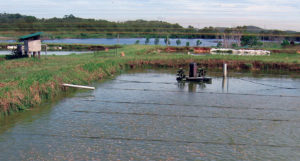
Dissolved oxygen concentrations in pond aquaculture
Various studies suggest that maintaining minimum daily dissolved oxygen concentrations above 3 mg/L in channel catfish and penaeid shrimp ponds assures better feed consumption and growth.
The use of phages is an alternative to antibiotics in the control of pathogenic bacteria. Phage therapy offers low-cost, low-toxicity treatment and quick bactericidal effects.

Various studies suggest that maintaining minimum daily dissolved oxygen concentrations above 3 mg/L in channel catfish and penaeid shrimp ponds assures better feed consumption and growth.

Hydrogen peroxide is a candidate for water treatment in aquaculture systems for it has antimicrobial effects and easily degrades to harmless byproducts.

In pilot-scale research, researchers found that both sequencing and membrane batch reactors removed ammonia, nitrite and suspended solids with great efficacy.

A range of motor sizes and types for regenerative blowers provides varied aquaculture applications with reliable performance, energy efficiency and minimal maintenance.

A socioeconomic and technical survey of prawn farmers in Thailand in 2005 assessed production practices, results and training.

Expansion of the India Organic Aquaculture Project is leading to organic freshwater prawn culture according to standards developed by Naturland Germany and Indocert.

The oxygen demand of feed represents the dissolved oxygen removed by the respiration of culture animals, microbial decomposition of uneaten feed and feces, and oxidation of ammonia nitrogen by nitrifying bacteria.

Carbon-nitrogen (C:N) ratio is an important variable related to soil fertility. Intensive ponds have lower C:N ratios, while higher ratios are found in extensive ponds and those constructed in organic soil.

Compliance with E.U. food laws was beneficial to aquaculture in the Philippines, but increased costs also initially created inequities for small farmers.

Recirculating systems, where probiotic, heterotrophic bacteria compete with pathogenic bacteria, can operate without antibiotics to produce tilapia and shrimp.

With the downturn in the global economy, interest is rising in backyard aquaculture systems ranging from simple tanks to setups requiring complex filtration, aeration and monitoring equipment.

Vertical integration to control the product from the first stages of production through packaging is an excellent way to minimize preventable risks.

Ultrasound offers a low-impact alternative to chemical treatments for unwanted algae, like chlorophyll a, and biofilms in aquaculture.

One way to jump start biofilter operation is by adding sugar, which can provide sufficient organic carbon to neutralize the ammonia-nitrogen produced.

Excessive concentrations of trace metals, especially copper, are toxic to phytoplankton and other aquatic plants. The ionic forms of trace metals are toxic to fish and other aquatic animals, but soluble, chelated trace metals are relatively non-toxic.